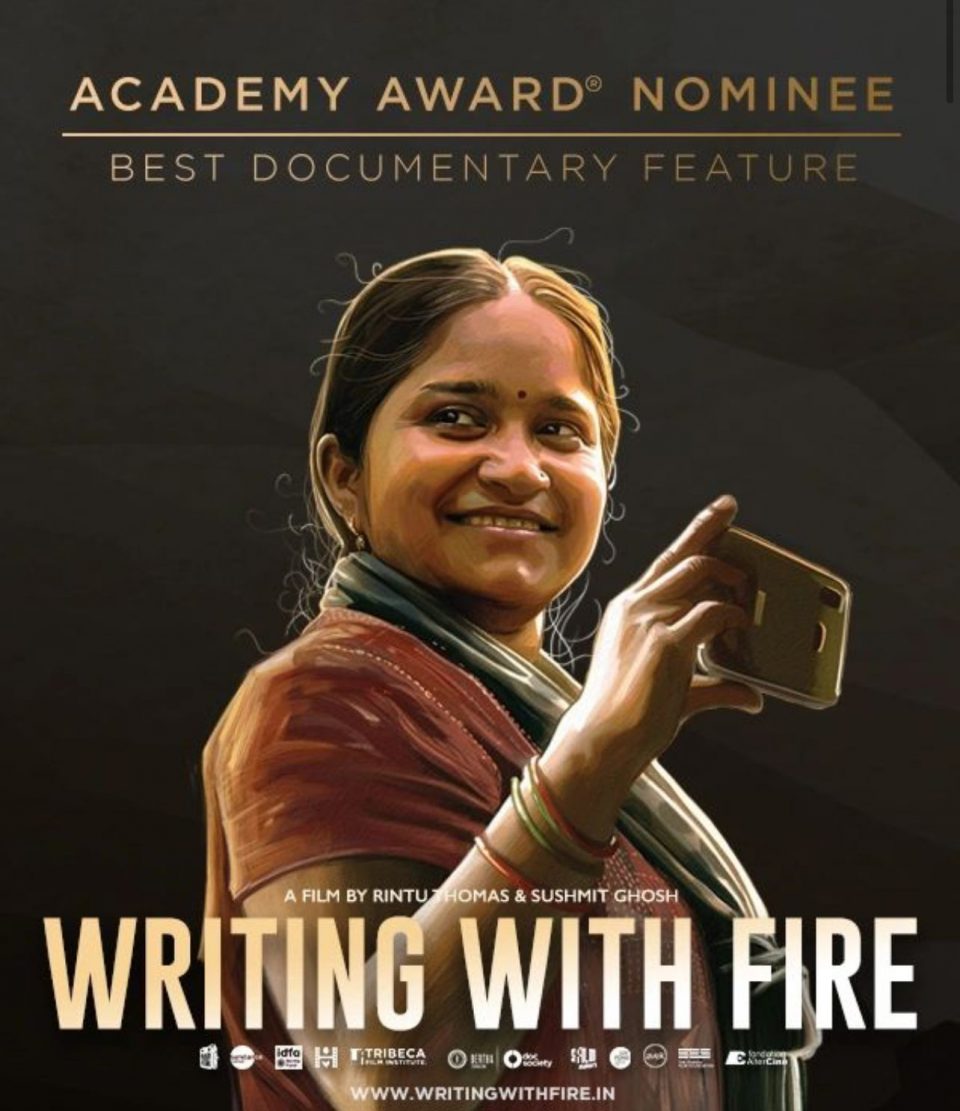Oscar-Nominated ‘Writing With Fire’ Tells the Inspiring Story of the Only Newspaper in India Run by Dalit women
Rintu Thomas and Sushmit Ghosh’s documentary about Khabar Lahariya also bagged an award at Sundance Film Festival last year
Meera Devi, the chief of the bureau of Khabar Lahariya (Waves of News), walks behind a spindly, bearded young man. He is carrying a sword in his hand, sheathed.
A member of Hindu Yuva Vahini, the vigilante Hindutva army created by the BJP’s Yogi Adityanath, the young man tells Meera about his father, a farmer who committed suicide, and says that he is keen on pursuing a career in politics and the route to acquiring power runs through cow protection, constant and overt display of Hindu solidarity and muscle, and ensuring that “Jai Shri Ram” is chanted and heard as a warning and a threat to Muslims.
Later, in his narrow, dingy room, where portraits of Hindu gods and goddesses decorate the grimy green wall, Meera is standing behind a tripod on which her mobile phone is mounted and asking him questions. Suddenly she asks him to take his sword out. The man’s face lights up and while sitting on his messy single bed, he slowly pulls the sword out of its sheath.
This scene, which comes somewhere in the middle of Rintu Thomas and Sushmit Ghosh’s documentary, Writing With Fire, is at once chilling and reassuring. It captures a critical moment in India’s history — it’s a moment when young men wearing saffron scarves and long red tilaks on their foreheads are adding momentum to the country’s slide towards a hate-filled majoritarian state, but also a moment that is being recorded and reported by a Dalit woman reporter.
Writing With Fire, the first-ever Indian documentary to make it to the list of five Oscar nominees in the Best Documentary Feature category tells the story of the independent, fearless, feminist, and only newspaper in India run by Dalit women, the Uttar Pradesh-based Khabar Lahriya.
Filmed over a four-year period, Writing With Fire begins in 2016, as Khabar Lahariya is transitioning from a print newspaper to becoming a digital news channel, and Uttar Pradesh is getting ready to vote. The film ends with the 2019 general elections.
Documentaries are tough to get right, not because they are often powered by the zeal to tell an important story that no one wants to tell, but because the directors who want to tell these stories make it about themselves. Their rage and politics often intervene and interrupt the story.
Thomas and Ghosh’s film, which has bagged several international awards, including at the Sundance Film Festival last year, and that credits Patty Quillin, philanthropist, and wife of Netflix CEO Reed Hastings, as one of its executive producers, plays the role of an interested observer.
It places Khabar Lahariya’s reporters at the center and lets us watch the stories they are covering as we would on news channels. Except that the stories these women reporters cover are not the stories we see on our screens.
Traveling by bus, trains, autos, and often walking the last several miles all alone on deserted, mud roads, Writing With Fire follows these reporters as they go looking for stories in homes that have been pushed outside the main villages — the houses of “untouchables”. Often it’s rape, unacknowledged deaths in illegal mines, lack of water, electricity, sanitation, road, basic medical care, promises unfulfilled, missing toilets.

We watch a woman tell Meera that she was raped by four men on January 2, 3, 8, 10, 16, and 19. But despite pleas and protests, no complaint has been registered. When Meera, with a copy of the complaint in her hand, asks the local SHO about the case, he dismisses her saying no such matter has been brought to his notice.
Sometimes their reporting has an impact. A healthcare center is set up, TB medicines arrive, water gushes into fields, a road gets fixed, electricity connection is restored. It’s empowering, reassuring, and in the “impact” reports they file, they can’t stop smiling. But as they return to their homes at night, to cook dinner while their husbands and fathers complain about their long hours, children talk of being mocked in school because of their caste, it feels like nothing has changed, and nothing ever will.
That is when the edit meetings in the office help. There are performance reviews, promotions, training sessions, discussions on what is happening, which issue to focus on, and a team-building trip to Kashmir energizes them again to cover the next rape, the next election rally, to verify the government’s new claims. But every time they go to report, they still get asked which caste they belong to.
During the course of filming Writing With Fire, Khabar Lahariya’s YouTube reputation grew and its views increased from 1 million to 141 million. But as Khabar Lahariya’s reporters began to question the UP government’s constant focus on religion, while ignoring the safety of women, rampant corruption, misgovernance, unkept promises, the comments below their video stories, which were earlier accompanied by hearts and red roses, turn abusive.
Writing With Fire is a sharp, empathetic and significant film that documents how journalism has empowered Dalit women reporters and the villagers, victims, people they write about. It also shows how having a voice, an opinion has made these women more vulnerable and that they work despite the constant fear of being attacked.
About 40 journalists have been killed in India since 2014. Writing With Fire tells a story that the government does not want to acknowledge because it puts a crimp in their claims and interrupts their bombast. Thomas and Ghosh’s Writing With Fire is going to the 94th Oscars ceremony in Los Angeles, but it has not yet been shown in India. For good reason.
Watch the trailer for Writing With Fire below








